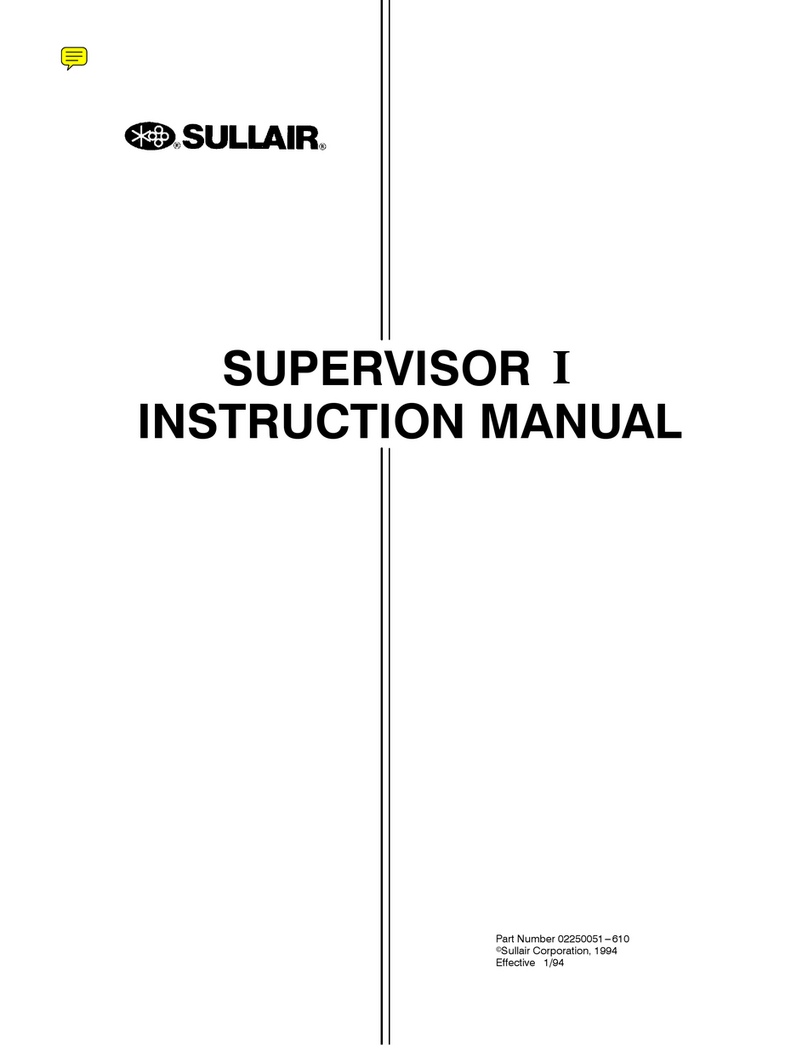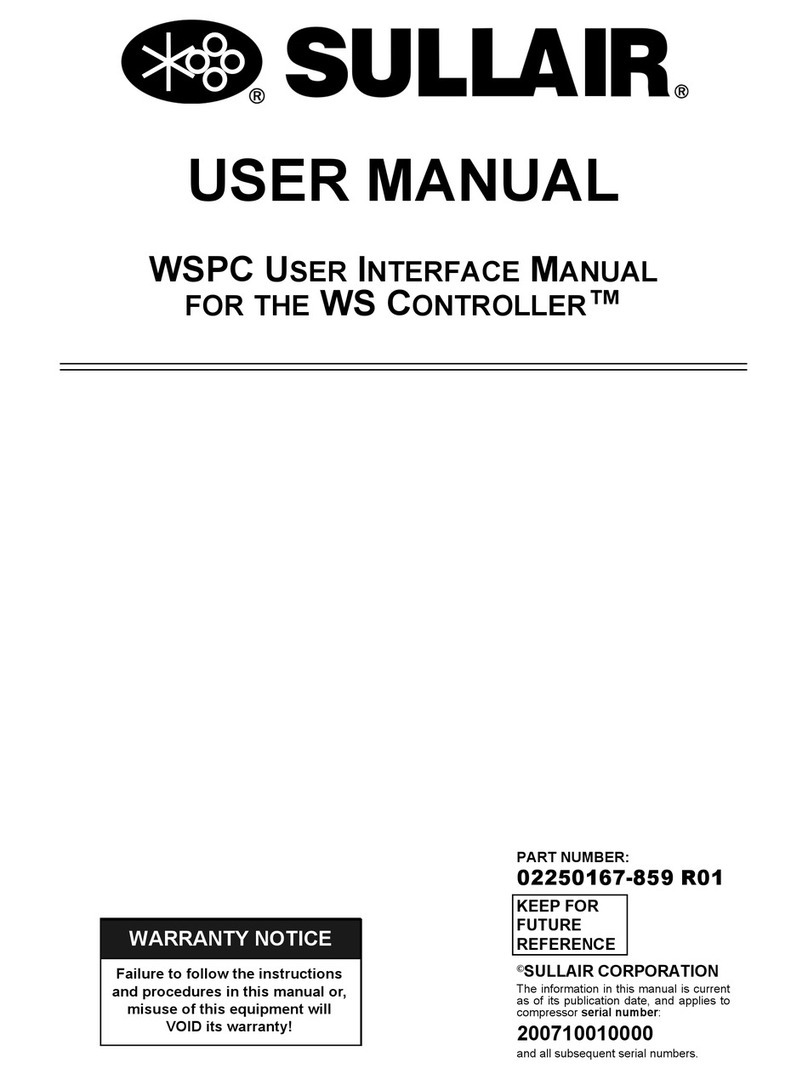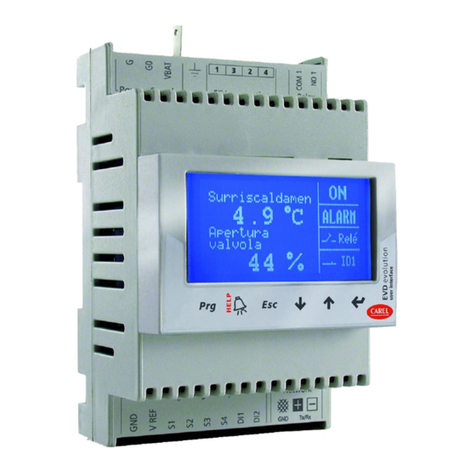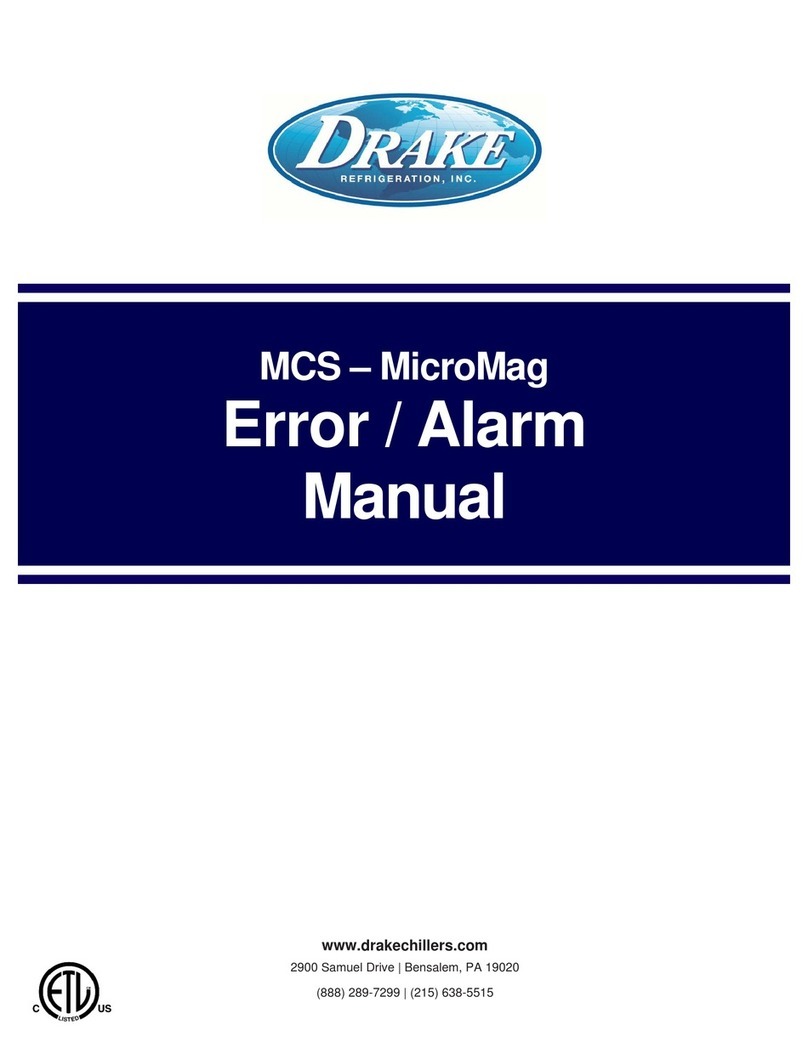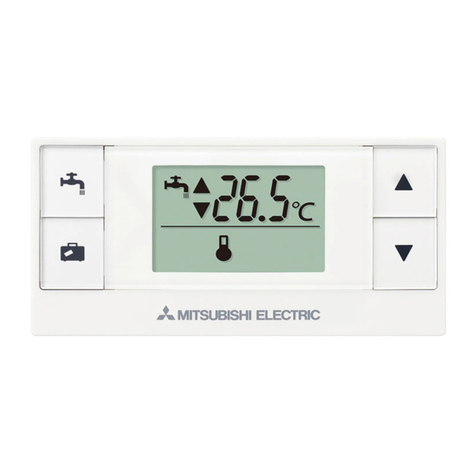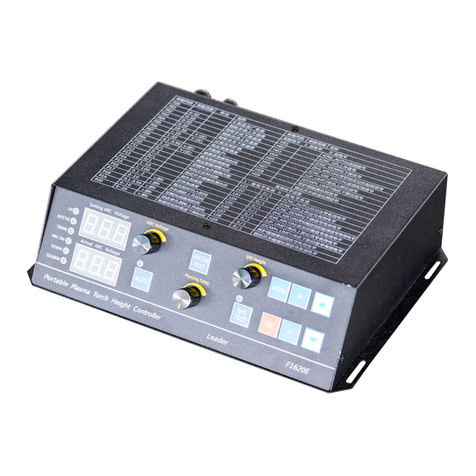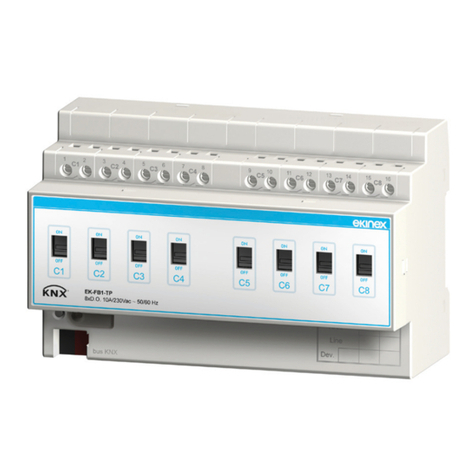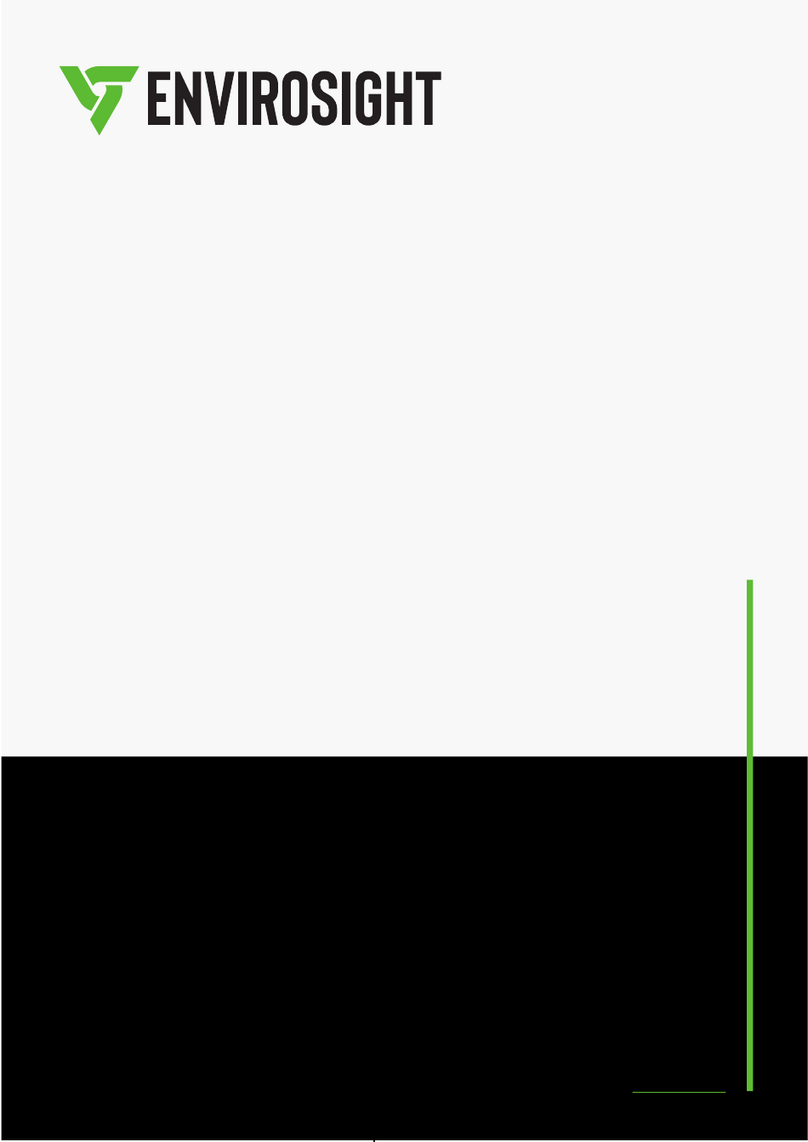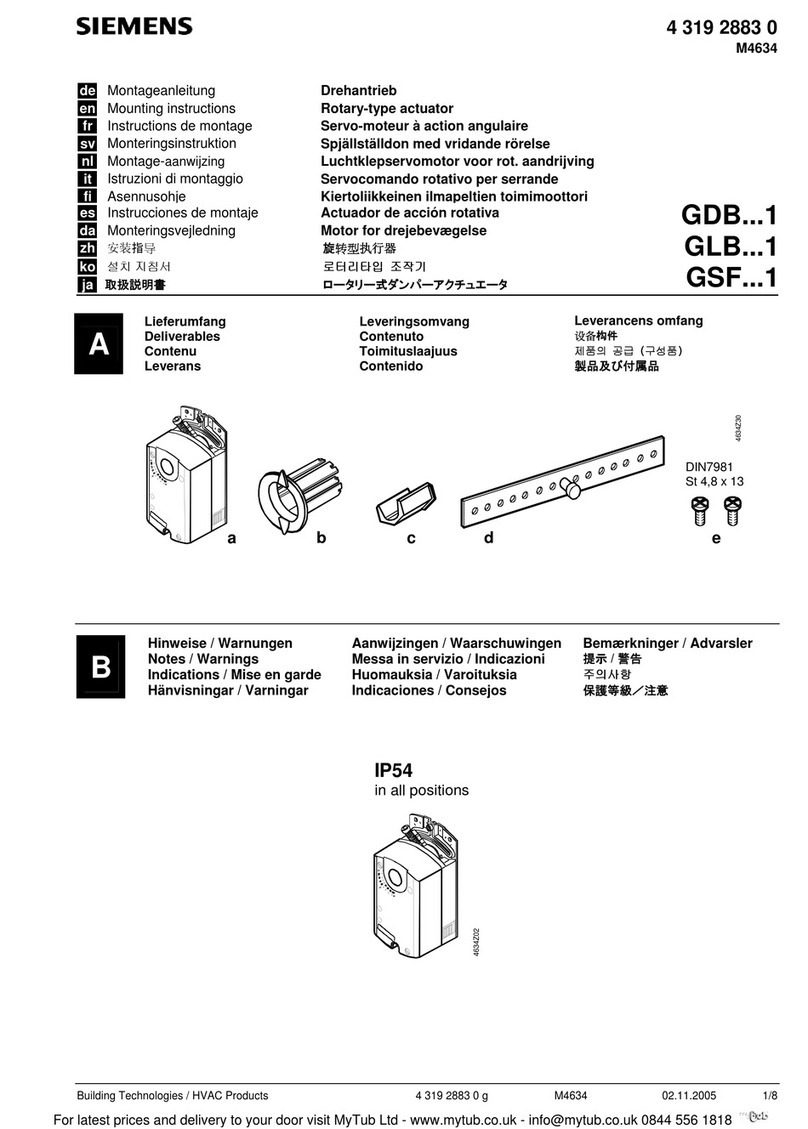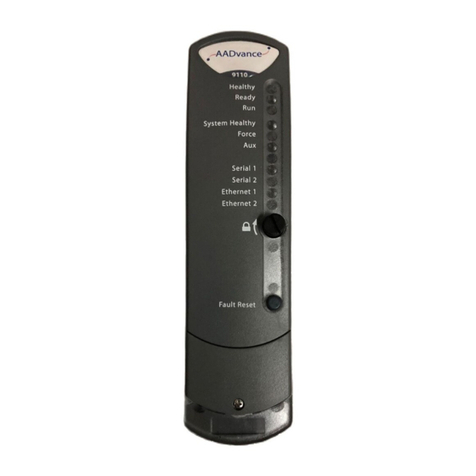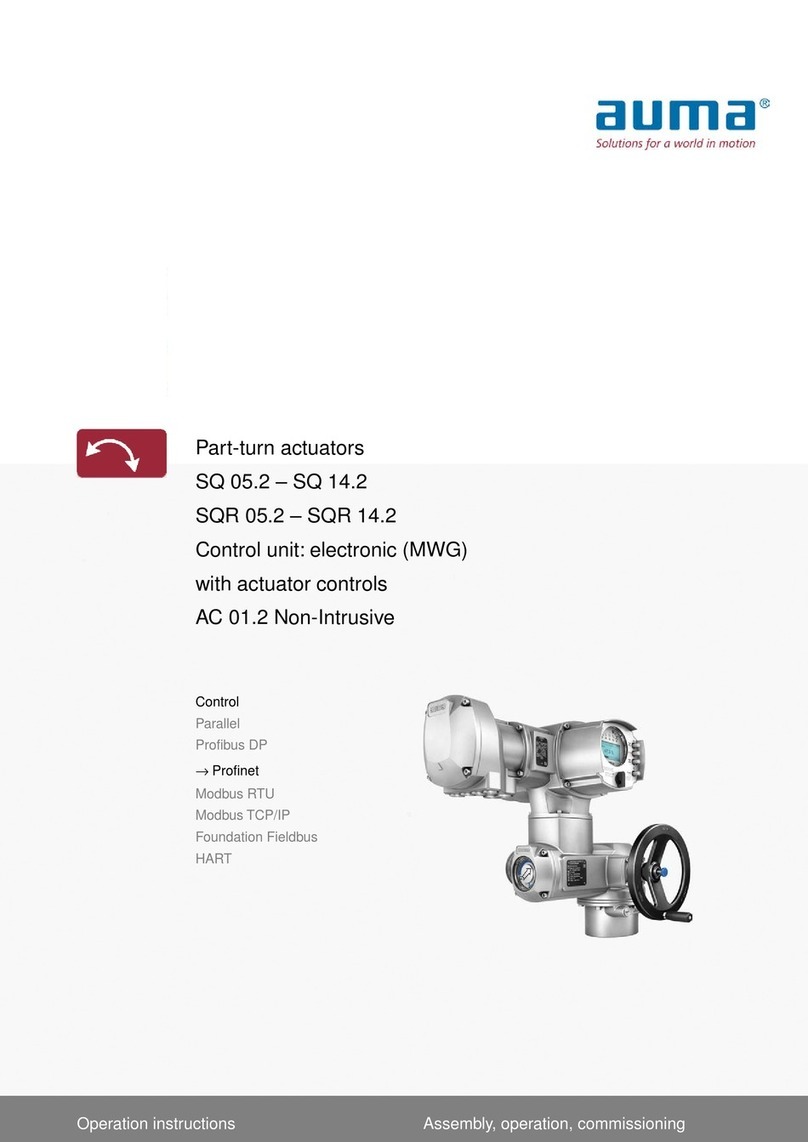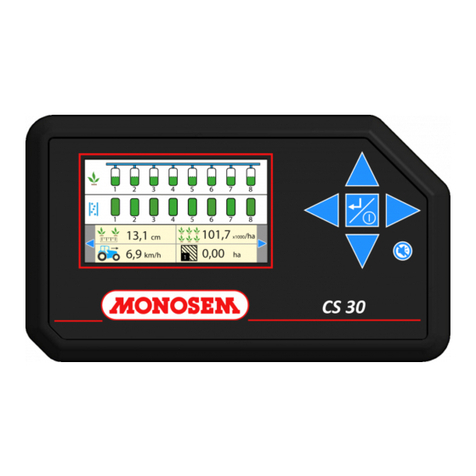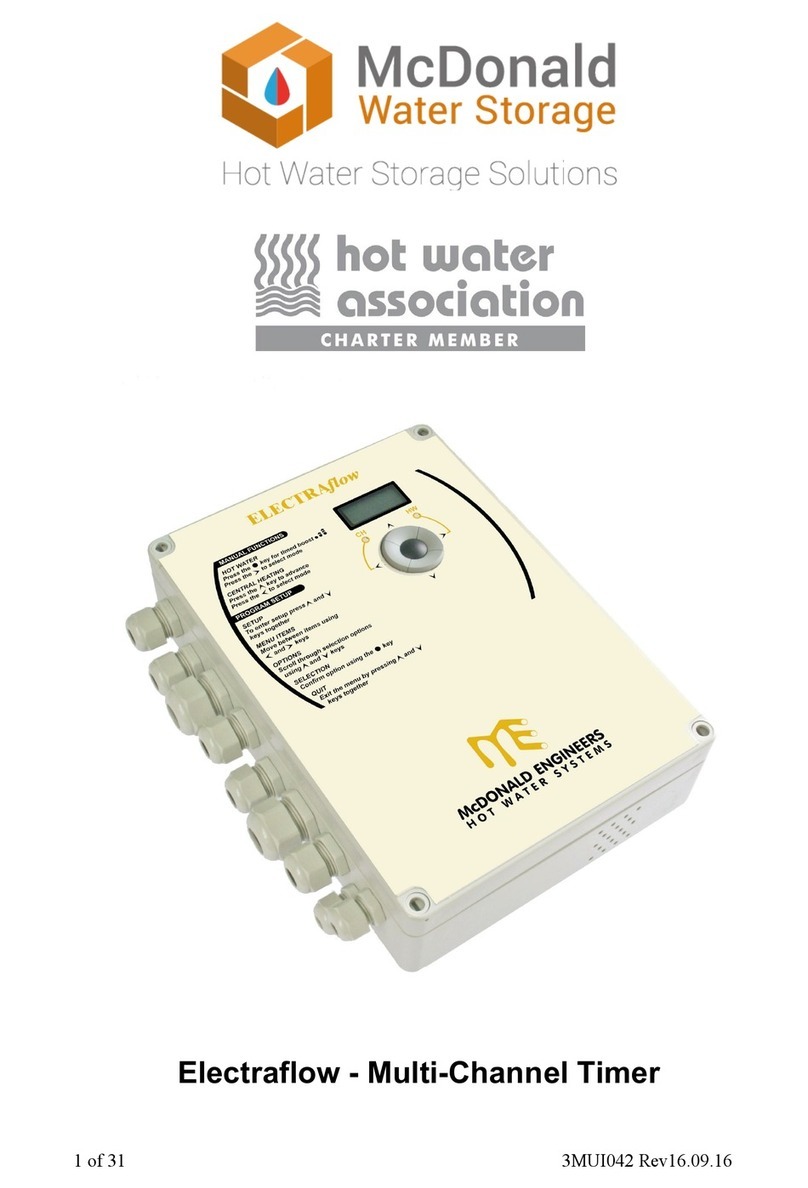Sullair SUPERVISOR CONTROLLER User manual

Failure to follow the instructions
and procedures in this manual or,
misuse of this equipment will
VOID its warranty!
WARRANTY NOTICE
PART NUMBER:
KEEP FOR
FUTURE
REFERENCE
USER MANUAL
©SULLAIR CORPORATION
The information in this manual is current
as of its publication date, and applies to
compressor serial number:
and all subsequent serial numbers.
02250146-049 R02
200906010000
SUPERVISOR CONTROLLER™

AIR CARE SEMINAR TRAINING
Sullair Air Care Seminars are courses that provide hands-on instruction for the proper operation, maintenance,
and servicing of Sullair products. Individual seminars on Stationary compressors and compressor electrical
systems are offered at regular intervals throughout the year at Sullair’s corporate headquarters training facility
located at Michigan City, Indiana.
Instruction includes training on the function and installation of Sullair service parts, troubleshooting common
faults and malfunctions, and actual equipment operation. These seminars are recommended for maintenance,
contractor maintenance, and service personnel.
For detailed course outlines, schedule, and cost information contact:
SULLAIR TRAINING DEPARTMENT
1-888-SULLAIR or
219-879-5451 (ext. 5623)
www.sullair.com
- Or Write -
Sullair Corporation
3700 E. Michigan Blvd.
Michigan City, IN 46360
Attn: Service Training Department.

TABLE OF CONTENTS
SECTION 1—SAFETY
3 1.1 GENERAL
3 1.2 PERSONAL PROTECTIVE EQUIPMENT
3 1.3 ELECTRICAL SHOCK
4 1.4 DECALS
SECTION 2—DESCRIPTION
7 2.1 SUPERVISOR KEYBOARD LAYOUT
8 2.2 MAIN DISPLAY
8 2.3 FUNCTION MENU
9 2.4 STATUS—CURRENT PRESSURES, TEMPERATURES, INPUTS AND
OUTPUTS
9 2.5 CONTROL PARAMETERS—PRESSURE, TEMPERATURE AND TIMER
SETTINGS
10 2.6 MAINTENANCE—PREVENTIVE MAINTENANCE INFORMATION AND
TIMERS
10 2.7 FAULT LOG—LOG OF PREVIOUS FAULTS
10 2.8 SENSOR LOG
10 2.9 SEQUENCING—SEQUENCING & COMMUNICATION PARAMETERS
11 2.10 SYSTEM DISPLAY—DISPLAY OF MODES OF MACHINES IN A SE-
QUENCING SYSTEM
11 2.11 CALIBRATION—CORRECTION FACTORS FOR PRESSURES
12 2.12 TEST
12 2.13 FACTORY SETUP- MODEL SETTINGS.
SECTION 3—START-UP PROCEDURES
15 3.1 MOTOR ROTATION DIRECTION CHECK
15 3.2 INITIAL START-UP PROCEDURE
15 3.3 SUBSEQUENT START-UP PROCEDURE
15 3.4 SHUTDOWN PROCEDURE
SECTION 4—TROUBLESHOOTING
17 4.1 TROUBLESHOOTING INTRODUCTION

TABLE OF CONTENTS
26 4.2 MACHINE BEHAVIOR AFTER A POWER OUTAGE
26 4.3 REMOTE STOP/START INPUT
26 4.4 BROWN OUT INPUT
SECTION 5—WIRING DIAGRAMS
SECTION 6—VARIABLE SPEED DRIVE
33 6.1 SAFETY
34 6.2 OVERVIEW
36 6.3 INSTALLATION
36 6.4 SUPERVISOR DISPLAY AND MENUS
37 6.5 STARTUP OF NEW COMPRESSOR PACKAGE
38 6.6 FAULT AND WARNING CODES
41 6.7 COMMISSIONING YOUR VSD:
41 6.8 AFTER THE FIRST 48 HRS OF OPERATION:
41 6.9 EVERY SIX MONTHS
41 6.10 EVERY TWELVE MONTHS:
42 6.11 CLEANING VSD HEAT SINKS
46 6.12 CLEANING VSD HEAT SINK FILTERS

Section 1
3
SAFETY
1.1 GENERAL
Sullair Corporation and its subsidiaries design and
manufacture all of their products so they can be
operated safely. However, the responsibility for safe
operation rests with those who use and maintain
these products. The following safety precautions are
offered as a guide which, if conscientiously followed,
will minimize the possibility of accidents throughout
the useful life of this equipment.
The compressor should be operated only by those
who have been trained and delegated to do so, and
who have read and understood this Operator's
Manual. Failure to follow the instructions, procedures
and safety precautions in this manual may result in
accidents and injuries. NEVER start the compressor
unless it is safe to do so. DO NOT attempt to operate
the compressor with a known unsafe condition. Tag
the compressor and render it inoperative by
disconnecting and locking out all power at source or
otherwise disabling its prime mover so others who
may not know of the unsafe condition cannot attempt
to operate it until the condition is corrected.
Install, use and operate the compressor only in full
compliance with all pertinent OSHA regulations and/
or any applicable Federal, State, and Local codes,
standards and regulations. DO NOT modify the
compressor and/or controls in any way except with
written factory approval.
While not specifically applicable to all types of
compressors with all types of prime movers, most of
the precautionary statements contained herein are
applicable to most compressors and the concepts
behind these statements are generally applicable to
all compressors.
1.2 PERSONAL PROTECTIVE
EQUIPMENT
A. Prior to installing or operating the compressor,
owners, employers and users should become
familiar with, and comply with, all applicable
OSHA regulations and/or any applicable Federal,
State and Local codes, standards, and regula-
tions relative to personal protective equipment,
such as eye and face protective equipment,
respiratory protective equipment, equipment
intended to protect the extremities, protective
clothing, protective shields and barriers and elec-
trical protective equipment, as well as noise
exposure administrative and/or engineering con-
trols and/or personal hearing protective equip-
ment.
1.3 ELECTRICAL SHOCK
A. This compressor should be installed and main-
tained in full compliance with all applicable Fed-
eral, State and Local codes, standards and
regulations, including those of the National Elec-
trical Code, and also including those relative to
equipment grounding conductors, and only by
personnel that are trained, qualified and dele-
gated to do so.
B. Keep all parts of the body and any hand-held
tools or other conductive objects away from
exposed live parts of electrical system. Maintain
dry footing, stand on insulating surfaces and DO
NOT contact any other portion of the compressor
when making adjustments or repairs to exposed
live parts of the electrical system. Make all such
adjustments or repairs with one hand only, so as
to minimize the possibility of creating a current
path through the heart.
NOTE
OPERATOR IS REQUIRED TO READ
ENTIRE INSTRUCTION MANUAL.

SECTION 1
4
C. Attempt repairs in clean, dry and well lighted and
ventilated areas only.
D. DO NOT leave the compressor unattended with
open electrical enclosures. If necessary to do so,
then disconnect, lock out and tag all power at
source so others will not inadvertently restore
power.
E. Disconnect, lock out, and tag all power at source
prior to attempting repairs or adjustments to
rotating machinery and prior to handling any
ungrounded conductors.
1.4 DECALS
See Figure 1-1. The Supervisor control panel
contains several decals which contain necessary
information for safe performance. These decals
should never be removed. If a decal becomes
damaged, contact your nearest Sullair Department
for replacement parts (Note: When ordering new
decals, use part number printed on decal face).
DANGER
All field equipment must be tested for elec-
trostatic fields prior to servicing or making
contact with the machine using the follow-
ing or equivalent test equipment:
• 90-600 VAC: Volt detector such as
Fluke Model 1AC-A
• 600-7000 VAC: Voltage detector
such as Fluke Networks Model
C9970
It is the responsibility of each organization
to provide/arrange training for all their
associates expected to test for electrostatic
fields.

SECTION 1
5
Figure 1-1: Decals
KEY
NO. PART NO.
Q
T
Y
DESCRIPTION NOTE
1 250017-903 1 decal, warning auto start
2 250027-935 1 decal, danger breath air (I)
3 250003-144 1 sign, warning “food grade” lube
4 041065 1 decal, auto start
(I) OSHA and FDA guidelines are superseded by any Federal, State or
Local regulations whenever applicable.

NOTES
6

Section 2
7
SUPERVISOR CONTROLLER™ USER MANUAL
DESCRIPTION
2.1 SUPERVISOR KEYBOARD
LAYOUT
Refer to Figure 2-1. The Display module has eleven
keys grouped in two rows.
The top row has the following seven keys :
—Help key, used to display possible causes of
and correction for an alarm or fault.
—Returns to main display.
—Used to edit text or numbers (move cursor
left).
—Used to edit text or numbers (move cursor
right).
—Used to change numbers or text, or scroll.
—Used to change numbers or text, or scroll.
—Used to select an item from a menu, or start
Figure 2-1: Supervisor Controller Panel

SUPERVISOR CONTROLLER™ USER MANUAL SECTION 2
8
and end an edit on a parameter.
The bottom row has four keys :
—Stop, stops machine. Clears faults and
warnings if machine is stopped.
—Run, starts machine. Clears warnings if
machine is running.
—Toggles auto mode.
—Toggles Local/Remote mode. This can be
used to disable sequencing.
2.2 MAIN DISPLAY
Line 1—Machine state :
E-Stop—E-Stop button pressed, or auxiliary E-Stop
present.
Stopped—Machine not running.
Unloaded—Machine running unloaded.
Loaded—Machine running, loaded and modulating.
Full Load—Machine forced to full load. (Used only in
sequencing modes).
Remote Stop—Compressor is off but armed to start.
The machine will start when the remote start contact
is closed. NOTE : the machine may start at any time.
Seq Stop—Compressor is off but armed to start. The
machine will start when the sequencing conditions
meet the criteria to start. NOTE: the machine may
start at any time.
Trim—Machine running, loaded and modulating in a
sequenced system.
Line 2—Fault or Warning, blank means no fault or
warning is present. If there are multiple alarms, they
will be shown for 2 seconds each. If an alarm is
active, pressing the ‘?’ key will give troubleshooting
information on that alarm.
Line 3—P2—Line pressure
Line 4—T1—Discharge Temperature
2.3 FUNCTION MENU
While in the main display, if any of the arrow keys are
pressed, the function menu is displayed. This menu
is used to view status or edit parameters.
The function menu has the following entries :
Status—Current pressures, temperatures, inputs
and outputs.
VSD Satus—(VSD packages only) See Section 6.
Control Parameters—Pressure and temperature
and timer settings.
Maintenance—Preventive maintenance information
and timers.
Fault Log—Log of previous faults.
Sensor Log—Log of sensor readings leading up to a
fault.
Sequencing—Sequencing parameters.
System Display—Display of modes of machines in
a sequencing system.
Calibration—Correction factors for pressures.
Test—Used by Sullair personnel for troubleshooting
serial communications.
Factory Setup—Model settings.
VSD Setup—(VSD Packages only) See Section 6.
To select a function, use the up and down arrow keys
to scroll to the desired function as indicated on last
line of display, then press the enter key.
After entering a function, the information can be
viewed by using the up and down arrow keys. If the
function shows status then values cannot be
changed. If the function displays parameters, then
the values can be changed.
To change a value, scroll to the line to be changed
using the up arrow and down arrow keys, and push
the enter button. The value can be changed by using
the up arrow or down arrow keys. When editing is
finished, pushing the enter key will fix the value. If
during a change the ESC key is pushed, editing is
terminated and the original value is reset.
The left and right arrow keys can be used to move to
other digits or letters in a value. For example to
change a value from 100 to 500, the left arrow key
can be used to position the cursor to the 1 digit in the
100, and the up arrow key used to increment the digit
to 5.
Text fields can also be edited in the same manner.
Push the enter key to start the edit, use the left and

SECTION 2 SUPERVISOR CONTROLLER™ USER MANUAL
9
right arrow keys to move to the letter to be changed,
then use the up and down arrow to change the letter.
Push the enter key to complete the edit. The
following are detailed descriptions of the various
displays.
2.4 STATUS—CURRENT
PRESSURES,
TEMPERATURES, INPUTS
AND OUTPUTS
All inputs and outputs are displayed showing both the
designator and the description (eg. T1- Discharge)
along with the selected temperature (C or F) or
pressure (psi, bar, kPa) units. Digital inputs and
outputs are shown either as a ‘0’ (zero) or ‘1’ (one).
Zero is off and one is on. This is a view only display.
The order of display is :
Temperatures—T1 through T4 depending on model.
Pressures—P1 through P4 depending on model.
Delta pressures—dp1 through dp3 depending on
model.
Load Hours—Hours machine has run loaded.
Run Hours—Hours machine has run loaded or
unloaded.
Load Cycles—Number of load/unload cycles.
Starts—Number of times machine has started.
E-Stop String—E-Stop push button.
Aux E-Stop—Auxiliary E-Stop, wired by customer.
Digital Inputs—D1 through D10, depending on
model.
Relay Outputs—K1 through K8, depending on
model.
2.5 CONTROL PARAMETERS—
PRESSURE, TEMPERATURE
AND TIMER SETTINGS
Parameters that control the operation of the machine
are viewed and set using this display. These
parameters may vary by machine model.
The Control Parameters are :
Unload pressure—The pressure where the machine
is unloaded. For example if this parameter is set to
110 psi (7.6 bar) the machine will unload when the
line pressure is above 110 psi (7.6 bar).
Load delta—The pressure differential below the
unload pressure where the machine is loaded. For
example if the unload pressure is set to 110 psi (7.6
bar) and the load differential is set to 10 psid (0.7
bar), the machine will load when the line pressure
goes below 100 psi (6.9 bar).
Setpoint—(VSD packages only) The targeted
pressure for the variable speed controls. This is
normally adjusted near the bottom of the load/unload
band above. The speed will be adjusted to maintain
this pressure. Refer to Section 6 for additional
details.
Unload Time—If the machine is running in AUTO
mode, this parameter specifies the amount of time
that the machine will run unloaded before shutting
off. If the time is set less than 15 minutes (for
example 5), there may be times when the machine
will run unloaded for more than 15 minutes. This is
because there is another timer that keeps the
machine from being started more than four times an
hour. This secondary timer is disabled when a
machine is configured for VSD motor control.
Drain Interval—If the machine has an electric
solenoid drain, this parameter and the following
parameter (Drain Time) are used to turn on the drain.
The interval is the time between activations of the
drain and the Drain Time is the length of the time
energized. This does not apply to the Sullair SCD
zero loss drain, which is not controlled or monitored
by the Supervisor.
Drain Time—Length of time that drain is energized.
Restart time—
Time to wait after power up before starting machine.
This parameter is used to keep several machines
from starting at the same time after power up, or to
delay start until other equipment is started. If
disabled parameter is zero, the machine will not
automatically start after power up. If this parameter is
a number larger than zero, the machine restarts after
a delay defined by this time. For example, if the
WARNING
Enabling this function also enables auto-
matic restart after power recovery. Be sure
to depress the Emergency Stop button to
defeat this function when automatic start is
to be prevented.

SUPERVISOR CONTROLLER™ USER MANUAL SECTION 2
10
Restart Time is set to 10 seconds, then the machine
will be enabled to start after 10 seconds.
Wye to delta transition timer—Also used to control
the closed inlet start valve. Disable by setting to zero
(0), standard for full voltage start. Requires
approximately 4-6 seconds for wye-delta or solid
state starting.
Modulate—Default state is Yes for normal machine
control. Select No for Load/No Load operation.
Language select—English, German, Spanish,
Italian and French may be selected for display
language.
Temp Units—Temperature units may be set to
degrees F or degrees C.
Press Units—Pressure units may be set to psi, bar,
or kPa.
(VSD packages only)—Additional adjustments for
VSD operation are shown in Section 2.
2.6 MAINTENANCE—
PREVENTIVE
MAINTENANCE
INFORMATION AND TIMERS
The following lines are on the Maintenance display.
Information—The top two lines may be changed to
advise what to do when there is a maintenance
warning. For example a distributor can put in his
name and telephone number.
Ser. No—Serial number of machine.
Warn at—When the following drop below this
number, a warning is issued.
Oil Filter hours—Hours before oil filter change.
PN—Oil Filter part number.
Separator hours—Hours before separator change.
Prim.—Primary separator part number.
Sec.—Secondary separator part number.
Air Filter hours—Hours before air filter change.
Prim.—Primary air filter part number.
Sec.—Secondary air filter part number.
Oil hours—Hours before oil change.
PN—Oil part number.
Oil Anal.—Hours before oil analysis.
These hours and part numbers can be changed
using the enter and arrow keys.
2.7 FAULT LOG—LOG OF
PREVIOUS FAULTS
The fault log shows the last 16 faults that occurred.
The top line of the display shows the run hours where
the fault occurred, and the second line shows the
fault. The faults can be scrolled through using the up
and down arrow keys. They are ordered by most
recent first. (ie. when the function is entered the most
recent fault is displayed. Pressing the down arrow
displays the previous fault etc).
2.8 SENSOR LOG
Log of sensor readings leading up to a fault.
The sensor log shows the sensor readings leading
up to a fault. The top line shows the last fault. The
following lines show T1, T2, P1 & P2. Each line
represents readings that are 5 seconds apart for one
minute, then one minute apart for 10 minutes. There
is a second set of readings for T3, T4, P3 & P4.
2.9 SEQUENCING—
SEQUENCING &
COMMUNICATION
PARAMETERS
The following parameters can be viewed and edited.
For more details on sequencing see the Supervisor
Sequencing and Protocol Manual.
Sequence By—Sequencing mode can be set to:
Disabled—Control does not do any sequencing.
Remote—Enables Remote Start/Stop, Remote
Load/Unload and Local/Master inputs
Hours—Uses the Seq Hrs parameter to deter
mine order of sequencing
Number—Uses the Com Number to determine
order of sequencing
Seq Hrs—This is an hour counter used when the
‘Sequence By’ parameter is set to ‘Hours’. Each hour
NOTE
Unload pressure MUST be lowered to
rated pressure when using Load/No Load
mode.

SECTION 2 SUPERVISOR CONTROLLER™ USER MANUAL
11
that the machine is running increments this counter.
When then ‘Sequence By’ parameter is set to
‘Hours’, the machine with the least amount of Seq
Hrs is started first, and the machine with the most
Seq Hrs is shut off first.
Com Number—Communications number. When two
or more machines are connected together using the
network (RS-485 channel), each machine must have
a unique number or address. These must be
assigned in numerical order. For example in a three
machine system the machine communications
numbers should be 1, 2 & 3.
Machines—This is the total number of machines
connected to the network (RS-485 channel). For
example in a three machine system, this parameter
should be set to 3. Up to sixteen machines may be
networked if all have Supervisor Controllers and
limited to eight if some have Supervisor II’s.
Low Press—This is the lowest pressure allowed
before immediately starting a machine. Recovery
Time—This parameter keeps multiple machines from
loading, unloading and starting at the same time. For
example if a low pressure condition causes a
machine to start, the next machine will not start
unless the Recovery Time has elapsed, and the
pressure has not recovered (i.e., has risen over ‘Low
Press’).
Rotate—This parameter is used only in very special
cases.
The only time this parameter should be used is in a
situation where, once a machine is started, it never
stops (ie. the unload timer never expires). This can
happen when the load matches the output of the
machine, all the time. In this case the machine will
never unload and shut off. The rotate forces the
machine to stop after it’s Seq Hrs. are greater that
the other machines. For example in a two machine
system, with Rotate set at 100 hrs. The machine that
is running will shut off when the Seq Hrs. are 100
more that the machine that is stopped.
Minute, Hour, Day, Month, Year—For Controllers
manufactured after April 2009 or if the
Communications Module is present in the system,
the time and date can be set using these parameters.
2.10 SYSTEM DISPLAY—DISPLAY
OF MODES OF MACHINES IN
A SEQUENCING SYSTEM
Note that this display is only applicable when there
are two or more machines connected to the
communications network (RS-485) and the
Sequence By parameters on each machine are set to
‘Hours’ or ‘Number’.
The columns are described below
Communication Number Status—
E—Emergency Stop
M—Manual stop
R—Remote stop
B—Standby
S—Starting
U—Unloaded
L—Loaded
T—Trim machine
F—Full load
Sequencing Hours
Capacity—Not used at this time.
Local System Pressure—Pressure read by
machines pressure transducer.
The top line is a legend that describes each column.
The right hand number on the top line is the system
pressure. The system pressure is the highest
pressure reading of all the machines. Note that the
local pressure readings can be used to determine
what machines may need to be calibrated. The
system pressure transducers on all machines should
read within 1(one) psi of one another. The calibration
function can be used to set the readings to be the
same.
2.11 CALIBRATION—
CORRECTION FACTORS
FOR PRESSURES
The first line of this display is the password. If the
password is 0 then the following parameters are not
protected and can be changed. If the password is
non-zero, then enter the displayed number plus 4 to
enable changing the parameters. For example if the
number displayed is 10 then changing the password
to 14 will enable editing.
NOTE
Leave this parameter disabled unless
instructed by Sullair Service Personnel.

SUPERVISOR CONTROLLER™ USER MANUAL SECTION 2
12
The four pressures P1, P2, P3 & P4 as well as the
differential pressure dP1 can be calibrated. The
number on the right hand side of the line is added to
the transducer reading to give the calibrated reading.
The calibrated reading is shown in the middle of the
line.
Cap and KW calibration (VSD packages only) may
be used to adjust values shown on VSD Status
displays. These are factory set to nominal values
(100%), but may be adjusted as desired.
There are also three other parameters in the
calibration function:
Protect—When set to yes, protects the control
parameters from change.
Fault on Warn—Force fault on warning.
Force Unload—When set to yes, forces the machine
to unload.
2.12 TEST
Used by Sullair personnel for troubleshooting of
serial communications.
2.13 FACTORY SETUP- MODEL
SETTINGS.
The factory setup display is used by Sullair personnel
to initially set up the machine. The following values
reflect the machine configuration.
Model—Model number of machine.
Cooling—Air or Water.
Press Trans—Pressure transducer range 200, 250,
500.
P1 Max—Maximum discharge pressure.
KT Fluid—Yes or No, indicating fluid.
Water Switch—Water pressure switch, Yes or No.
Oil Switch—Oil pressure differential switch, Yes or
No.
Min Load Psi—Minimum acceptable load P1
pressure setting. Separator Maintenance warning is
disabled for loaded P1 pressures below this value
(i.e., during start-up).
Lube Cycle—Pre-lube/ Post-lube function timer - 0
seconds (disabled) to 30 seconds.
K8 Option—K8 output relay function selector—
Disabled, Oil pump prelube and postlube control,
Master Control for special external sequence control.
Stop Timer—Time to run machine before stopping.
Protect—Protect control parameters.
Load Hours—Hours machine was running and
loaded.
Run Hours—Hours machine was running loaded
and unloaded.
Load Cycles—Number of load/unload cycles.
Starts—Number of machine starts.
Capacity—Maximum capacity of machine.
Spiral Valve—(VSD packages only) Yes or No,
indicating spiral valve control.
VSD- Describes signal from Supervisor controls to
the VSD controls:
None—No VSD
Pressure—The Supervisor pressure signal is
connected to a drive analog input
Serial—The drive is connected on the
Supervisor serial data bus
Speed—The Supervisor provides a speed
signal to a drive analog input.
Com Module—Yes/No Enables or disables the
communication module if installed.

13
NOTES

SUPERVISOR CONTROLLER™ USER MANUAL SECTION 2
14
Table 2-1: Supervisor Controller Menu Tree

Section 3
15
SUPERVISOR CONTROLLER™ USER MANUAL
START-UP PROCEDURES
3.1 MOTOR ROTATION
DIRECTION CHECK
After the electrical wiring has been done, it is
necessary to check the direction of the motor
rotation. With the control system in MANUAL mode,
press the and pads in succession to
bump start the compressor. When looking at the
motor from the end opposite the compressor unit, the
shaft should be turning clockwise on all gear driven
models, and counterclockwise on direct drive
models. If the motor shaft is not turning in the proper
direction, disconnect the power to the starter and
exchange any two of the three power input leads,
then recheck rotation. A “Direction of Rotation” decal
is located on the coupling guard between the motor
and compressor to show proper motor/compressor
rotation.
Variable speed drive packages will have main motor
direction set at the time of construction, but the fan
direction is affected by installation. If fan-cooled,
ensure that fan rotation is correct. To change
direction, disconnect the power and exchange any
two of the three fan motor leads at the fan motor
starter.
3.2 INITIAL START-UP
PROCEDURE
The following procedure should be used to make the
initial start-up of the compressor.
1. Be sure that all preparations and checks
described in the Installation Section have
been made.
2. Read the preceding pages of this manual
thoroughly.
3. Jog motor to check for correct rotation of fan
(refer to Section 3.1).
4. Start the compressor in the desired operating
mode or .
5. Slowly open the shut-off valve to the service
line.
6. Check for possible leaks in piping.
7. Slowly close the shut-off valve to assure
proper nameplate pressure unload setting is
correct. The compressor will unload at
nameplate pressure. If adjustments are nec-
essary, see Control System Adjustment sec-
tion in the compressor operator’s manual.
8. Observe the operating temperature. Refer to
compressor operator’s manual for accept-
able operating range. If temperature
exceeds this range, the cooling system and
installation environment should be checked.
9. Open shut-off valve to the service line.
10. Reinspect the compressor for temperature
and leaks the following day.
3.3 SUBSEQUENT START-UP
PROCEDURE
On subsequent start-ups, check that the proper level
is visible in the fluid sight glass and simply press the
START or AUTO MODE button. When
the compressor is running, observe the instrument
panel and maintenance indicators.
3.4 SHUTDOWN PROCEDURE
To shut the compressor down, simply press the
STOP button.

16
NOTES

Section 4
17
SUPERVISOR CONTROLLER™ USER MANUAL
TROUBLESHOOTING
4.1 TROUBLESHOOTING
INTRODUCTION
The information contained in the Troubleshooting
chart has been compiled from factory experience. It
contains symptoms and usual causes for the
described problems. However, DO NOT assume that
these are the only problems that may occur. All
available data concerning the trouble should be
systematically analyzed before undertaking any
repairs or component replacement procedures.
A detailed visual inspection is worth performing for
almost all problems and may avoid unnecessary
additional damage to the compressor. Always
remember to:
a. Check for loose wiring.
b. Check for damaged piping.
c. Check for parts damaged by heat or an
electrical short circuit, usually apparent
by discoloration or a burnt odor.
Should your problem persist after making the
recommended check, consult your nearest Sullair
Distributor or the Sullair Corporation factory Service
Department.
NOTE
Whereas Section 4.1 and Section 4.2 por-
tray common systematic setbacks that
can occur during controller operation, for
a more thoroughly in-depth coverage of
machine operation setbacks, consult the
Troubleshooting Section in the machine’s
operator’s manual.
Table 4-1: Troubleshooting Guide—Supervisor Controller
Message Model Enable Probable Cause Remedy
Air Filter Maint ALL ALWAYS Differential Pressure
Across Inlet Filter High
Replace filter
Check inlet filter pressure
switch.
Aux Motor Overload ALL ALWAYS Auxiliary Motor Tripped on
Cooling Fan, Oil Pump or
Other Motor
Reset auxiliary overload after
heater element cools. Verify
correct motor amps.
Check for loose connections
Check motor starter contact
for proper operation.
Check line voltage, if low
consult power company.
E-Stop ALL ALWAYS E-Stop Button Active Release button.
E-Stop Push Button Check wiring

SUPERVISOR CONTROLLER™ USER MANUAL SECTION 4
18
E-Stop ALL ALWAYS Auxiliary E-Stop String
Open
Check auxiliary E-Stop
devices.
E-Stop String Check wiring.
Low Water Pressure ALL Water-
cooled
Cooling Water Pressure
Below 10 psi (0.7bar)
Check for closed valves or
broken pipes.
Oil Change Due, Oil Filter
Change, Separator Change
Due, Air Filter Change, Oil
Analysis Due, Maintenance
Due
ALL ALWAYS Maintenance Due Select Maintenance from
menu to see service due and
part numbers.
Main Motor Overload ALL ALWAYS Main Motor Overload Reset overload after heater
element cools down.
Make sure compressor is
properly configurated.
Make sure load pressure is
set below limit of compres-
sor.
Check motor starter contacts
for proper operation.
Check line voltage, if low
consult power company.
I/O Mod Com Error, Com Mod
Com Error, Motor Mod Com
Error, VSD Com Error
ALL ALWAYS Module Network Error; The
Network that Connects the
Display Module, I/O Mod-
ule and Other Optional
Modules is Not Working
Correctly
Check wiring.
Replace module referred to
in error message, if problem
persists replace display mod-
ule.
Oil Filter Maint., dP2 Oil Filter
High
ALL ALWAYS Pressure Across Oil Filter
Above 20 psi (1.4 bar)
While Running
Oil filter clogged, replace oil
filter.
FLOODED ALWAYS Low ambient temperature,
sump heater may be
required in ambients below
40°F (4°C).
ALL ALWAYS Sensor failure, check sen-
sor, wiring and tubing.
Table 4-1: Troubleshooting Guide—Supervisor Controller
Message Model Enable Probable Cause Remedy
Other manuals for SUPERVISOR CONTROLLER
2
Table of contents
Other Sullair Controllers manuals
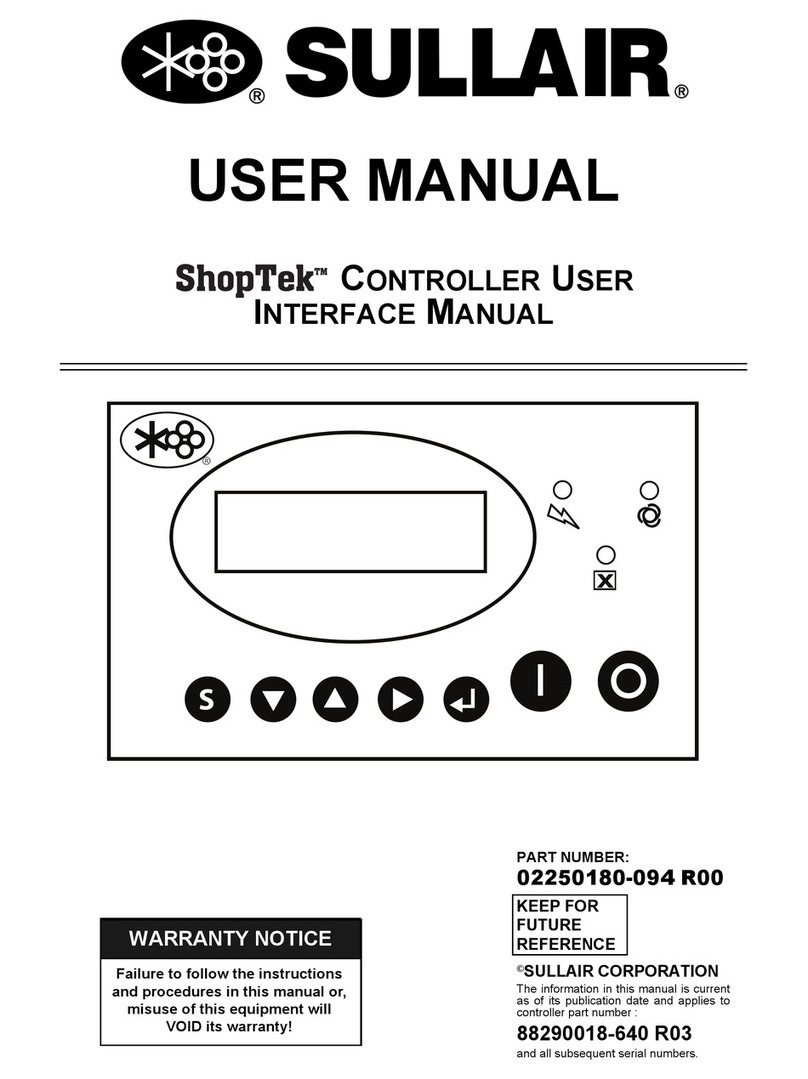
Sullair
Sullair ShopTek User manual
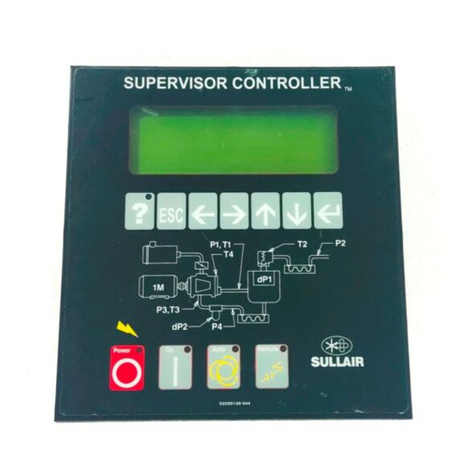
Sullair
Sullair SUPERVISOR CONTROLLER Series User manual
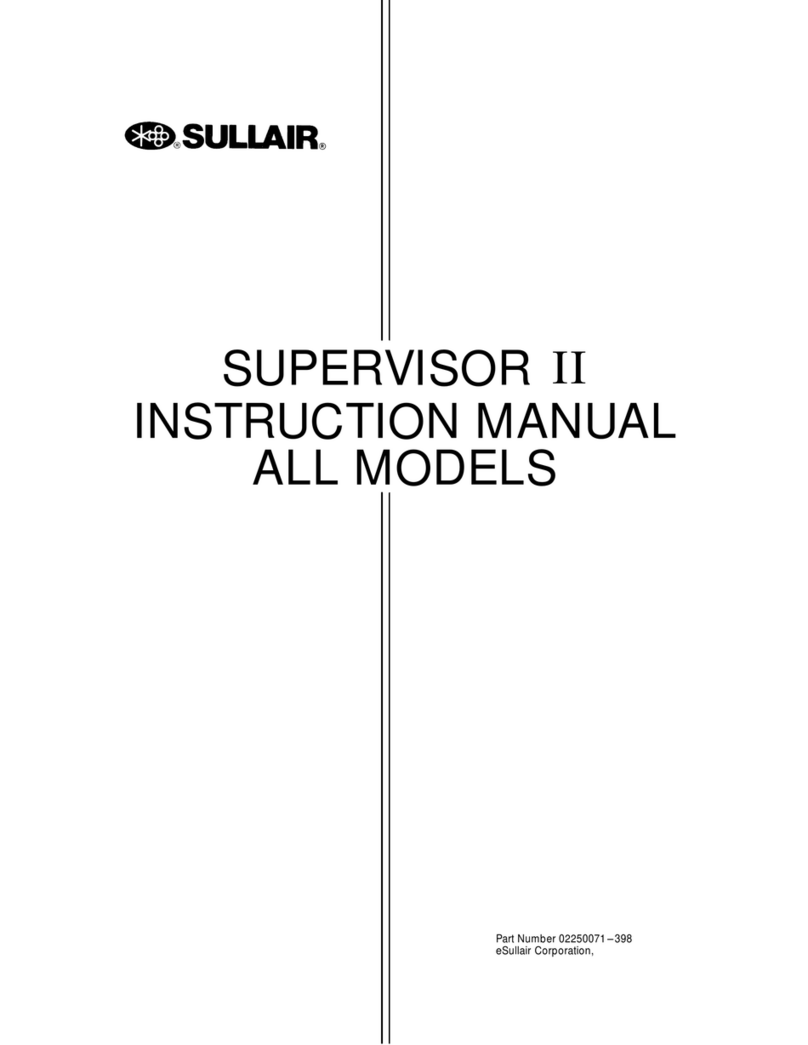
Sullair
Sullair Supervisor II User manual

Sullair
Sullair 02250165-411 R01 User manual
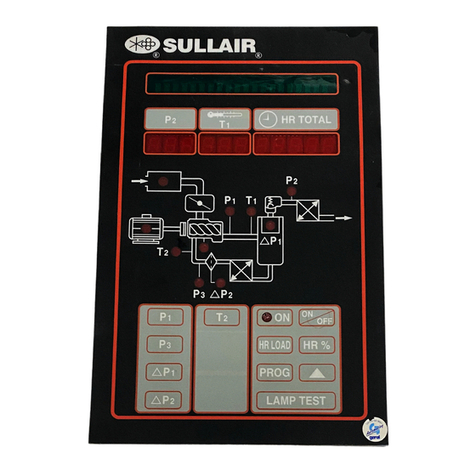
Sullair
Sullair SUPERVISOR CONTROLLER User manual

Sullair
Sullair 02250160-842 User manual
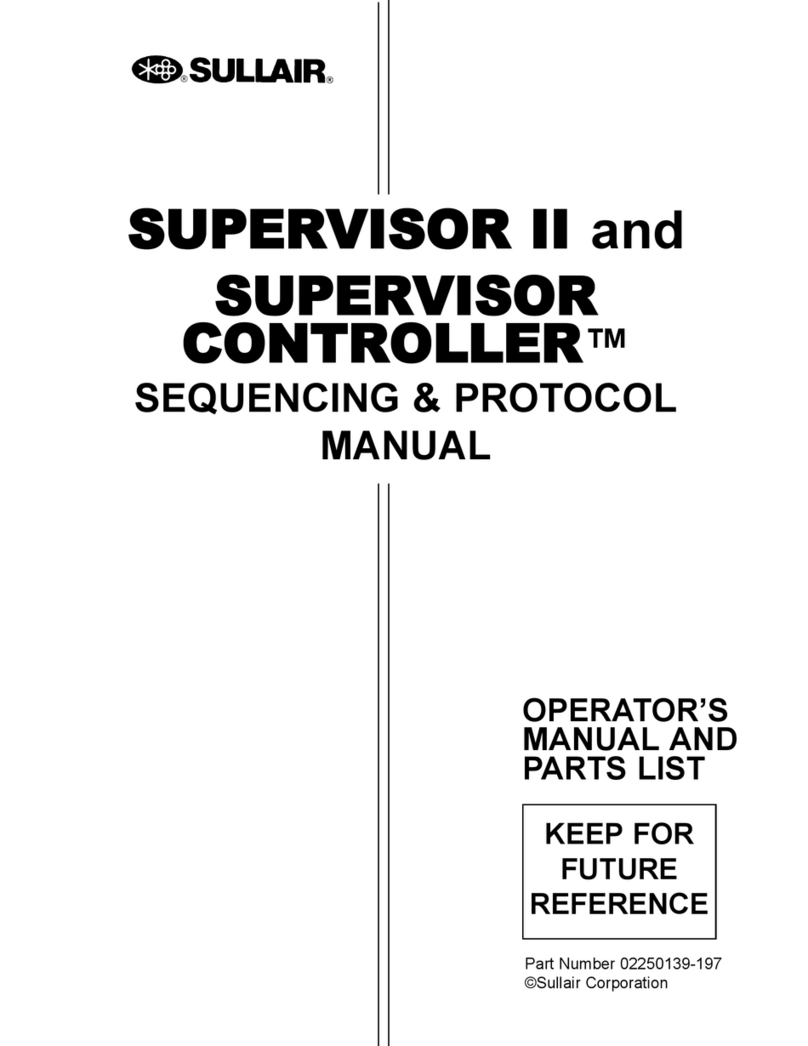
Sullair
Sullair SUPERVISOR II Series User manual

Sullair
Sullair 900 User manual
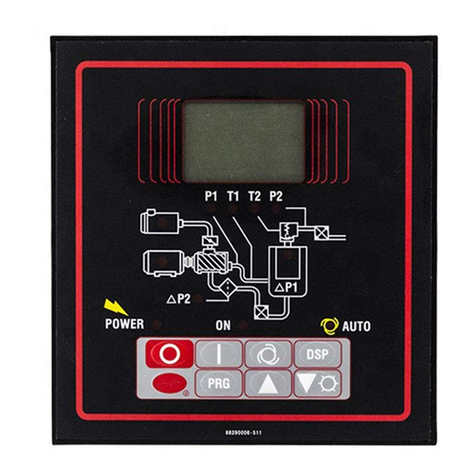
Sullair
Sullair SUPERVISOR CONTROLLER User manual
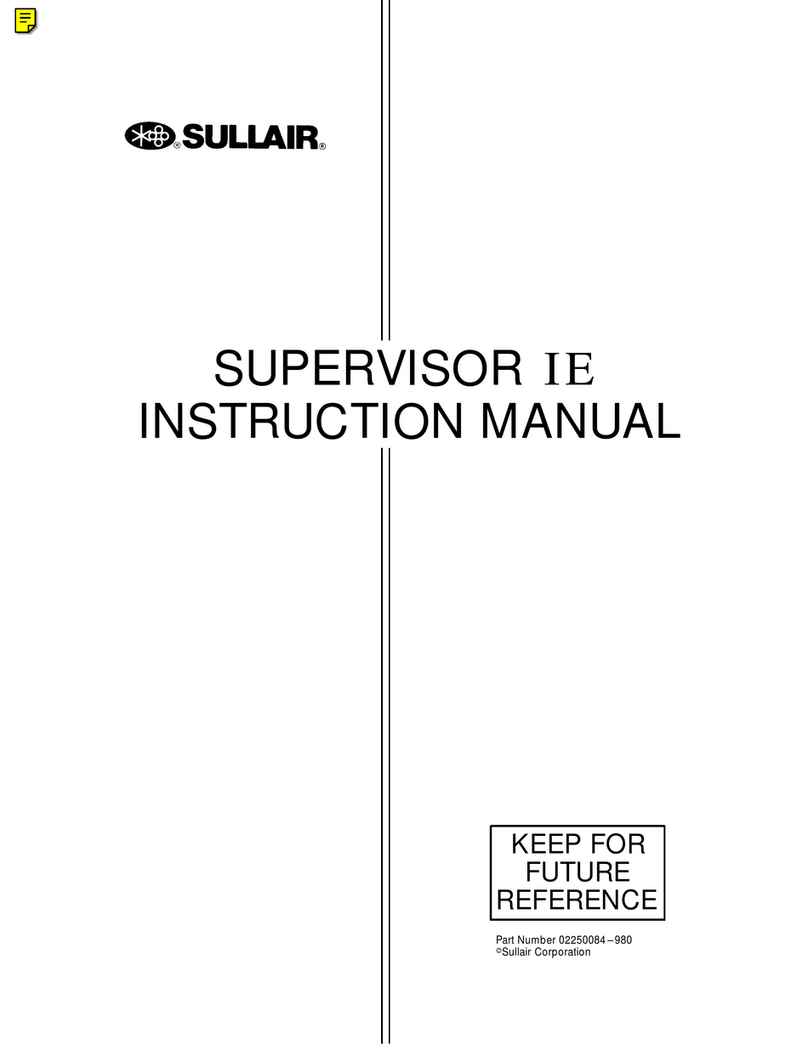
Sullair
Sullair Supervisor IE User manual
